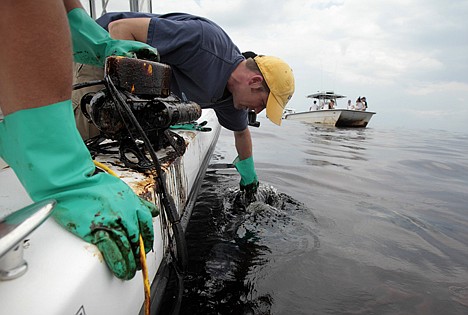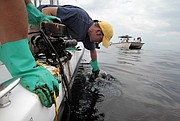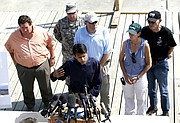BP: Effort to plug spill going as planned
Greg Bluestein | Hagadone News Network | UPDATED 15 years, 7 months AGO
ROBERT, La. - BP started pumping heavy mud into the leaking Gulf of Mexico well Wednesday and said everything was going as planned in the company's boldest attempt yet to plug the gusher that has spewed millions of gallons of oil over the last five weeks.
BP hoped the mud could overpower the steady stream of oil, but chief executive Tony Hayward said it would be at least 24 hours before officials know whether the attempt worked. The company wants to eventually inject cement into the well to seal it.
"I'm sure many of you have been watching the plume," Hayward said of the live video stream of the leak. "All I can say is it is unlikely to give us any real indication of what is going on. Either increases or decreases are not an indicator of either success or failure at this time."
The stakes are high. Fishermen, hotel and restaurant owners, politicians and residents along the coast are fed up with BP's so far ineffective attempts to stop the leak that sprang after an offshore drilling rig exploded April 20. Eleven workers were killed, and by the most conservative estimate, 7 million gallons of crude have spilled into the Gulf, fouling Louisiana's marshes, coating birds and other wildlife and curtailing fishing.
"We're doing everything we can to bring it to closure, and actually we're executing this top kill job as efficiently and effectively as we can," BP Chief Operating Officer Doug Suttles said Wednesday night.
The top kill has worked above ground but has never before been tried 5,000 feet beneath the sea. Company officials peg its chance of success at 60 to 70 percent.
President Barack Obama said "there's no guarantees" it will work. The president planned a trip to Louisiana on Friday.
"We're going to bring every resource necessary to put a stop to this thing," he said.
Engineers planned to monitor the well overnight and continue pumping in thousands of gallons of the drilling fluid, which is about twice as heavy as water.
"The absence of any news is good news," said Coast Guard Admiral Thad Allen, who is overseeing the operation. He added: "It's a wait and see game here right now, so far nothing unfavorable."
Meanwhile, dozens of witness statements obtained by The Associated Press show a combination of equipment failures and a deference to the chain of command impeded the system that should have stopped the gusher before it became an environmental disaster.
The live video stream Wednesday showed pictures of the blowout preventer and oil gushing out. At other times, the feed showed mud spewing out, but BP said this was not cause for alarm.
A weak spot in the blowout preventer could give way under the pressure, causing a brand new leak.
Frustration with BP and the federal government has only grown since efforts to stop the leak have failed.
Louisiana Gov. Bobby Jindal and Plaquemines Parish President Billy Nungesser, both outspoken critics, led a boat tour around the oil-fouled delta near the mouth of the Mississippi River. Some 100 miles of Louisiana coastline had been hit by the oil, the Coast Guard said.
Through the Mississippi's South Pass, there were miles-long passages that showed no indication of oil, and the air smelled fresh and salty. Nearby, fish were leaping and tiny seabirds dove into the water.
But not far away at Pass a Loutre, the oily water smelled like an auto shop.
"There's no wildlife in Pass a Loutre. It's all dead," Nungesser said.
BP has had some success in siphoning oil from a mile-long tube, which has sucked up 924,000 gallons of oil since it was installed last week. Engineers, though, had to move the device during the top kill.
The Coast Guard also said only a small amount of dispersants were used Wednesday in an effort to reduce the chemicals in the Gulf, but crews were continuing the burn and skim the oil off the surface.
Engineers are working on backup plans in case the procedure doesn't work, including a bid to cap the well with a small containment dome. Suttles, for his part, is trying to temper expectations. He said it's too early to express optimism about the top kill.
ARTICLES BY GREG BLUESTEIN
QB Michael Vick being held in Atlanta prison
ATLANTA - Michael Vick was back in Atlanta, the city where he rose to NFL stardom, but as a prisoner rather than a player, an official said Friday.
QB Michael Vick being held in Atlanta prison
ATLANTA - Michael Vick was back in Atlanta, the city where he rose to NFL stardom, but as a prisoner rather than a player, an official said Friday.
QB Michael Vick being held in Atlanta prison
ATLANTA - Michael Vick was back in Atlanta, the city where he rose to NFL stardom, but as a prisoner rather than a player, an official said Friday.





